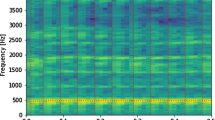Abstract
The universal concept of a “music of the spheres” traverses the history of philosophy, science and art, from Pythagoras to Kepler and beyond. In modern times, a sphere in three dimensions—the Bloch sphere—is used to illustrate the state of a qubit, the basic unit of quantum information. On the same spherical surface, the fundamental components of voice production can be located, so that any utterance can be seen as the evolution of a unit two-dimensional vector having complex coefficients. Indeed, any sound can be analyzed and decomposed into overlap** sinusoidal components, broadband noises, and impulsive transients, which in turn can be associated to fundamental means of vocal sound production, such as phonation, turbulence, and slow myoelastic vibrations or pulses. The quantum sphere can be made to sing the universal sound.
Access this chapter
Tax calculation will be finalised at checkout
Purchases are for personal use only
Similar content being viewed by others
Notes
- 1.
- 2.
Sound example evolutionDownBrr.wav. The recording is available at https://on.soundcloud.com/WL8AT.
- 3.
Sound example mixed_lines_brr.wav. The recording is available at https://on.soundcloud.com/tbkv3.
References
Berio, L. (1968). Sequenza III per voce femminile. Universal Edition.
Blutner, R., & Beim Graben, P. Gauge models of musical forces. Journal of Mathematics and Music (2020). https://doi.org/10.1080/17459737.2020.1716404.
Bogdanov, D., Wack, N., Gómez Gutiérrez, E., Gulati, S., Herrera Boyer, P., Mayor, O., Roma Trepat, G., Salamon, J., Zapata González, J. R., & Serra, X. Essentia: An audio analysis library for music information retrieval. In Proceedings of the 14th Conference of the International Society for Music Information Retrieval (ISMIR) (pp. 493–498) (2013).
Bonada, J., Serra, X., Amatriain, X., & Loscos, A. (2011). Spectral processing. In U. Zölzer (Ed.), DAFX: Digital audio effects (pp. 393–445). Wiley.
Costa Hamido, O., Cirillo, G. A., & Giusto, E.: Quantum synth: A quantum-computing-based synthesizer. In Proceedings of the 15th International Conference on Audio Mostly (pp. 265–268) (2020).
Dalla Chiara, M. L., Giuntini, R., Leporini, R., Negri, E., & Sergioli, G. (2015). Quantum information, cognition, and music. Frontiers in Psychology, 6, 1583.
Delle Monache, S., Rocchesso, R., Bevilacqua, F., Lemaitre, G., Baldan, S., & Cera, A. (2018). Embodied sound design. International Journal of Human-Computer Studies, 118, 47–59.
Friberg, A., Lindeberg, T., Hellwagner, M., Helgason, P., Salom\(\tilde{\text{a}}\)o, G. L., Elowsson, A., Lemaitre,G., & Ternström, S. Prediction of three articulatory categories in vocal sound imitations using models for auditory receptive fields. The Journal of the Acoustical Society of America, 144(3), 1467–1483 (2018).
Fugiel, B. Quantum-like melody perception. Journal of Mathematics and Music (2018). Retrieved from https://doi.org/10.1080/17459737.2022.2049383.
Gabor, D. Acoustical quanta and the theory of hearing. Nature, 159(4044), 591 (1947).
von Helmholtz, H. (1870). Die Lehre von den Tonempfindungen als physiologische Grundlagefürdie Theorie der Musik. F. Vieweg und sohn.
Koenig, D. M., & Delwin, D. F. (2015). Spectral analysis of musical sounds with emphasis on the Piano. Oxford University Press.
Lemaitre, G., & Rocchesso, D. On the effectiveness of vocal imitations and verbal descriptions of sounds. The Journal of the Acoustical Society of America, 135(2), 862 (2014). Retrieved from https://iris.unipa.it/retrieve/handle/10447/370549/745030/1.4861245.pdf.
Lemaitre G., Houix O., Voisin F., Misdariis N., & Susini P. Vocal imitations of non-vocal sounds. PLoS ONE, 11(12), e0168167 (2016). Retrieved form https://doi.org/10.1371/journal.pone.0168167.
Mannone, M., & Rocchesso, D. Quanta in sound, the sound of quanta: A voice-informed quantum theoretical perspective on sound. In E. R. Miranda (Ed.), Quantum computing in the arts and humanities. Springer, Cham (2022) Retrived from https://doi.org/10.1007/978-3-030-95538-0_6.
Marinetti, F. T.: Zang tumb tumb. Milano, Edizioni futuriste di poesia (1914). Retrieved from http://parliamoitaliano.altervista.org/zang-tumb-tumb/.
Miranda, E. R. Quantum computer: Hello, Music! In E. Miranda (Ed.), Handbook of artificial intelligence for music: Foundations, advanced approaches, and developments for creativity. Springer Nature (2021)
Miranda, E. R.: Creative Quantum computing: Inverse FFT sound synthesis, adaptive sequencing and musical composition. In A. Adamatzky (Ed.), Alternative computing. World Scientific (2021).
Newman, F. (2004). MouthSounds: How to whistle. Pop: Boing, and Honk... for All Occasions and Then Some. Workman Publishing.
Palazzeschi, A. La fontana malata, from Poemi. Firenze, Cesare Blanc (1909). Retrieved from https://www.pensieriparole.it/poesie/poesie-d-autore/poesia-38384.
Roads, C. (2001). Microsound. MIT Press.
Rocchesso, D., & Mannone, M. (2020). A quantum vocal theory of sound. Quantum Information Processing, 19, 292. https://doi.org/10.1007/s11128-020-02772-9
Verma, T. S., Levine, S. N., & Meng, T. H. Transient modeling synthesis: A flexible analysis/synthesis tool for transient signals. In Proceedings of the International Computer Music Conference (pp. 48–51) (1997).
Weimer, H. Listen to quantum computer music. http://www.quantenblog.net/physics/quantum-computer-music. Accessed 02 Jan 2021 (2010).
Author information
Authors and Affiliations
Corresponding author
Editor information
Editors and Affiliations
Rights and permissions
Copyright information
© 2022 The Author(s), under exclusive license to Springer Nature Switzerland AG
About this chapter
Cite this chapter
Mannone, M., Rocchesso, D. (2022). Sing and Measure: Sound as Voice as Quanta. In: Miranda, E.R. (eds) Quantum Computer Music. Springer, Cham. https://doi.org/10.1007/978-3-031-13909-3_12
Download citation
DOI: https://doi.org/10.1007/978-3-031-13909-3_12
Published:
Publisher Name: Springer, Cham
Print ISBN: 978-3-031-13908-6
Online ISBN: 978-3-031-13909-3
eBook Packages: Computer ScienceComputer Science (R0)




